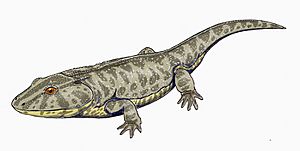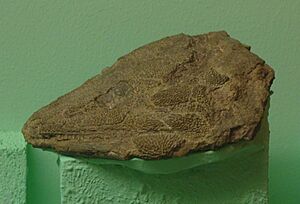Lydekkerina facts for kids
Quick facts for kids LydekkerinaTemporal range: Early Triassic
|
|
|---|---|
 |
|
| Life restoration of Lyddekerina huxleyi | |
| Scientific classification |
|
| Kingdom: | Animalia |
| Phylum: | Chordata |
| Order: | †Temnospondyli |
| Suborder: | †Stereospondyli |
| Family: | †Lydekkerinidae |
| Genus: | †Lydekkerina Broom, 1915 |
| Species | |
|
|
| Synonyms | |
|
|
Lydekkerina was an ancient amphibian that lived a very long time ago. It's an extinct type of temnospondyl, which were like early amphibians. Scientists have found its fossils in South Africa and Australia. These fossils date back to the Early Triassic period. That was about 250 million years ago!
Lydekkerina is special because, unlike many other amphibians of its time that lived partly in water, it spent all its time on land. The most well-known species is L. huxleyi, which was first described in 1889.
Contents
What Lydekkerina Looked Like
Lydekkerina was a fairly small amphibian. It could grow to be about 1 metre (3.3 ft) long. Its skull was shaped like a wedge, with a rounded front. The skulls found by scientists range from about 49 millimetres (1.9 in) to 100 millimetres (3.9 in) in length.
The surface of its skull had small, shallow pits. Lydekkerina had teeth not only in its jaws but also on the roof of its mouth. Some skulls even show large tusks on the underside.
Scientists can tell Lydekkerina apart from other similar animals by a few features on its skull. For example, it had tiny bumps called "vomerine shagreen" on the bones of its palate (the roof of its mouth). Also, an opening at the very front of its palate was divided by two bony parts from the skull roof. There were also special ridges under the skull roof around its eye sockets. These ridges probably helped make the skull stronger.
Discovery and Its Place in History
The first description of Lydekkerina huxleyi was in 1889. It was briefly described by Richard Lydekker as a species of another animal called Bothriceps. The name huxleyi honors Thomas Henry Huxley, an English biologist. He was the one who named the Bothriceps group in 1859.
Later, in 1915, a South African paleontologist named Robert Broom gave a better description of the species. He moved it to a new group, or genus, which he named Lydekkerina after Lydekker. More detailed studies of its jaw and other body parts were done in 2007.
Lydekkerina is one of the most common ancient amphibians found in the Karoo Basin of South Africa. Many fossils have been found in a specific area called the Lystrosaurus Assemblage Zone. However, many of these fossils are squashed or damaged. This has sometimes made it hard for scientists to identify them correctly.
Some scientists thought that differences in skull shapes might just be due to how the fossils were preserved, not because they were different types of animals. Because of this, in 2006, it was suggested that other similar animals found in South Africa, like Limnoiketes and Broomulus, were actually the same as Lydekkerina.
Other species were also named Lydekkerina at different times. For example, L. putterilli was named in 1930. But later, it was moved to its own group called Broomistega. Another species, L. kitchingi, was named in 1950. It was later found to be a young form of a different animal, and then even later, it was grouped with Laccosaurus.
In 2006, fossils of Lydekkerina huxleyi were also found in Australia. These Australian fossils had the same special features as those found in South Africa, like the ridges under the skull and the tiny bumps on the palate.
How Lydekkerina Lived
Scientists believe Lydekkerina lived only on land. This is because its bones were much stronger and thicker than those of other amphibians that lived in water. It also had large bony parts that likely helped attach strong muscles. The joints between its bones were well-developed, which would have allowed it to move easily on land.
Also, the special sensory system that helps many water animals feel pressure changes in water was not very developed in Lydekkerina. This suggests it didn't need these senses much in a land environment.
See also
 In Spanish: Lyddekerina para niños
In Spanish: Lyddekerina para niños


